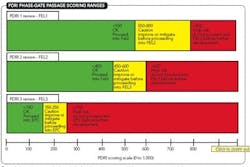Almost all best-in-class plant owners and contractors now rely on a phase-gated project delivery process (PDP), as depicted in Figure 1, to maximize the benefits of capital spending. They make "go/no go/recycle" decisions at stage gates, especially the ones at the end of each of the first three phases, the front-end loading ones (FEL 1–3). These gates also often are linked to funding decisions, either partial funding to support the next planning/development phase or full funding, usually at the completion of front-end engineering, to authorize the execution phase of the project.
The gatekeeper plays a crucial role in the PDP — ensuring a project advances to the next phase only if it fully satisfies clearly defined requirements. Because of the broad technical and project management knowledge needed to make decisions, the gatekeeper in reality should be a team or committee that provides cross-functional expertise for a constructive critical review of a project's state of readiness to proceed into the next phase.
Because gates represent critical decision points that may lead to authorizing considerable funds for the next phase or for terminating a project or revising it to achieve PDP requirements, teams generally rely on industry-recognized metrics and practices to ensure the project deliverables are adequate in content and quality to move the project to the next phase. Many organizations have invested, often heavily, over the years in developing effective PDP systems, techniques and tools.
However, many companies today must contend with staffing and funding limitations that compromise effective gatekeeping. Tasks typically are assigned to the most experienced personnel, who usually have the least amount of time available to analyze all the dimensions involved. So, in many cases, the recommended practices have turned into "check the box" exercises, conducted half-heartedly or solely to satisfy corporate requirements to obtain funding for the next phase.
Quite often, this results in "penny wise, pound foolish" drills that produce inflated scoring, leading to questionable projects moving to the next phase, or that overlook opportunities for significant capital- or operating-cost savings or schedule enhancements.
The impact of "mailing in" these assessments can range from simply embarrassing if expected outcomes aren't achieved, to catastrophic if a key corporate strategic project fails, devastating profitability or causing gross violations of environmental and safety regulations.
THE FIX
Companies must retain the functions needed to exercise effective due diligence in planning and executing projects. However, that doesn't mean they can afford to put experts on gatekeeper teams full-time. Instead, many firms rely on "cold eye" reviews conducted or facilitated by independent objective specialists with the necessary expertise to properly carry out such exercises. This approach cost-effectively provides specific expertise for short periods.
Cold eye reviews can apply to a wide variety of activities during the FEL 1–3 and execution phases, such as risk-management, project-readiness and cost/schedule assessments as well as peer reviews and full-scale independent project reviews.
The experts for cold eye reviews may come from third-party organizations — some of which have honed their skills in this area to make it a core competency — or from internal groups. Most importantly, it is essential that these experts aren't part of the project team.
Many companies concentrate their in-house expertise in project management offices or centers of excellence. Such internal groups contain a core of experienced practitioners, typically including subject matter experts (SMEs) in technical and nontechnical (e.g., project management) areas. Because these specialists generally aren't assigned to any project on a full-time basis, they usually are considered independent of the project team, thus satisfying objectivity and transparency requirements.
Sometimes a firm with such an internal group lacks enough experts for all reviews needed at the moment. In those cases, most organizations assign their specialists to projects with the most strategic value and then turn to outsourcing to fill any gaps on other projects. Some companies have set up contractual relationships with third parties to provide necessary levels of expertise on an "on-call" basis.
Regardless of whether they come from a third party or an internal group, experts used for cold eye reviews typically have extensive familiarity with application of industry best practices as well as in-depth experience with a broad range of projects. So, they can come up to speed on the particular project very quickly.
The task of these experts is not only to identify problems but also to provide practical recommendations for corrective measures, and to transfer some of their knowledge via "lessons learned" sharing, training, mentoring and coaching.
MORE THAN PEOPLE
The tools used in these cold eye reviews often are just as important as the experience of the team. Most world-class PDPs include techniques, tools, metrics and practices to facilitate effective disciplined project development and decision-making. Some of the metrics and practices are the Project Definition Rating Index (PDRI), project cost or schedule reviews, value-improving practices (VIPs) and project health checks. To ensure consistency across projects, the PDP should provide clear guidelines/standards as to the deliverables required and what's necessary to move beyond any specific gate.
The most effective teams rely on pre-established checklists or scoring sheets during reviews and apply task-appropriate methodology, making maximum use of quantifiable rather than subjective measures. The overall scoring associated with these assessments gives the review sponsor(s) and project team an important check as to where the project really stands in the process.
An example of a tool that has gained widespread acceptance and application as a best practice is the PDRI, which was developed by the Construction Industry Institute. The PDRI provides a scoring methodology that assesses appropriate-for-phase maturity of items such as business and project objectives, engineering deliverables and project execution planning. A project may undergo as many as three PDRI assessments — typically at the end of each of the first three phases (FEL 1–3), as detailed in Figure 2. PDRI results inform the gatekeepers of where the project actually resides within the process and what areas require further work to align with the appropriate phase.
While the project manager and project team can conduct PDRI scoring sessions by themselves, having a knowledgeable third party facilitate these sessions is considered a best practice. Experienced facilitators often bring fresh ideas and transparency required by investors and executive managers to support critical decisions.
VIPs (Figure 3), first promoted by Independent Project Analysis, Inc., are another example of the types of tools and techniques that can help improve projects and, simultaneously, provide gatekeepers with information related to PDP conformance. VIPs now have become an industry-recognized best practice to ensure scope development (technical considerations) properly integrates business requirements on a "no more, no less" basis.
To correctly define a project and align technical bases with business and project objectives and drivers, the team should apply (during FEL) as many of the twelve recognized formal VIPs as deemed appropriate for the project. This requires conducting formal workshops at appropriate timeframes within the project lifecycle. These workshops generate reports that are used to integrate value-adding ideas as well as to provide gatekeepers with documentation to aid in their decision-making.
An independent and objective facilitator is crucial for such workshops. Although not considered cold eye reviews per se, these sessions demand the same qualities and qualifications for a facilitator. The "outside" facilitator must be trained, and for some VIPs, certified, in the VIP methodology, to review (in a workshop environment) specific engineering aspects to maximize the value of the project. Most organizations now opt to use external resources to facilitate these workshops.
Not all VIPs apply to all projects and, in fact, some may conflict with each other — e.g., process reliability (i.e., maximum uptime) may well clash with value engineering (i.e., minimum capital cost). Effective application of VIPs often can reduce capital costs or execution schedules by as much as 10% or cut operating and maintenance costs comparably.
Various studies as well as experience show that projects correctly following the PDP roadmap, including using proven effective tools and techniques, as well as objective outside experts, gain significant savings and operations benefits. Companies wind up "doing the right projects," confident the selected ones will provide predictable results that achieve the projects' objectives.
ADDITIONAL REVIEWS
Peer reviews, which focus on a specific set of project deliverables and typically involve SMEs (internal or third party) not on the team, also can provide benefits. Such reviews usually occur prior to formal gate reviews (during FEL). However, it's not uncommon to apply peer review principles to activities such as major design reviews or project execution plan reviews during early project execution stages. If any issues are identified, the peer review and project teams then must reach agreement on effective corrective actions.
For larger more-complex projects, full-scale independent project reviews — conducted during the 70%-completion portion of FEL 3 or early in phase 4 — can play a valuable role in construction readiness assessments. These reviews cover a broad range of project considerations such as cost, schedule, risk and resources, and provide a more in-depth analysis of project deliverables. Typically a team of SMEs (internal or third party) from several disciplines conducts the review.
The cold eye reviewers must objectively assess the status of the project or deliverables in question, unencumbered by any preconceived sponsor, gatekeeper, management or project team impressions. Their charter is to provide an accurate evaluation of where the project actually stands, pointing out both positive and negative factors.
For a PDRI scoring session, for example, they should derive a totally independent objective score and present this to the project team. The reviewers should pinpoint, in quantifiable dimensions, gaps that must be addressed as well as areas where additional effort is unnecessary or even counter-productive. They should include gap closure plans, including recommendations for improving those areas that haven't yet progressed to the appropriate maturity/quality for passage to the next project phase. These gap closure suggestions can prove invaluable in putting a project back on course, thereby preventing the huge costs associated with error correction during execution (Figure 4).
To permit proper analysis, the independent experts must receive phase-appropriate project deliverables before they begin review/scoring sessions. Traditional engineering/technical deliverables, such as piping and instrumentation drawings, process flow diagrams and plot plans, are essential — but so, too, are project management and project controls information such as the project execution plan, cost estimate, cost estimate basis memorandum, project schedule and schedule basis, and project risk register.
After outside experts have thoroughly evaluated this information, they should interview selected key project team personnel, preferably in person, using a set of standard questions supplemented by specific questions derived from the project documentation review. Interviews typically should take 60 to 90 minutes. They should be conducted in a secure location that enables the interviewee to speak candidly without fear of reprisal or group pressure. The summary of the interviews should not attribute comments to any particular individual.
REAP THE BENEFITS
Cold eye reviews, if held early enough, planned well, thoroughly implemented and properly followed-up upon, can provide critical information to project teams — allowing them, with management assistance, to correct or upgrade areas with deficiencies, address miscommunication, and promote a successful outcome. Many times, project team personnel know of deficiencies but don't bring them up because they lack the proper forum to do so. Sometimes, a team doesn't realize its view of project goals doesn't square with management's.
So, such reviews should not be looked upon as "make work" drills to be casually conducted by self-interested parties, but rather as opportunities to assess where projects really stand, close gaps and significantly enhance the potential for success.
Successful reviews and facilitated improvement efforts will ensure projects achieve their objectives, while effectively identifying and capturing any opportunities to further optimize value and exceed goals.
BRETT W. BAILEY is general manager, management and consulting, for Pathfinder, LLC, Cherry Hill, N.J. E-mail him at [email protected].






